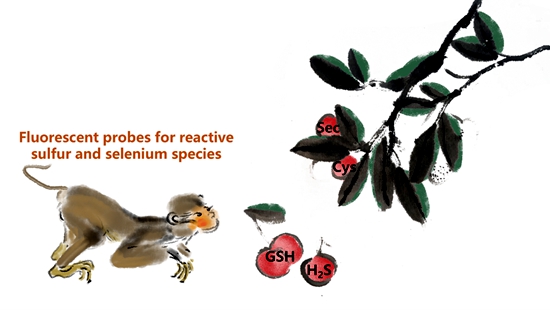Fluorescent Probes Based on Nucleophilic Aromatic Substitution Reactions for Reactive Sulfur and Selenium Species: Recent Progress, Applications, and Design Strategies
Recently, the functional livestock products team of the Beijing Institute of Animal Science (IAS) has systematically reviewed the latest developments in the research of reactive sulfur and selenium fluorescent species probes based on nucleophilic aromatic substitution reactions. This paper has been published online in Coordination Chemistry Review.
According to Dr. Zhang Junmin, the co-corresponding author of this paper, sulfur and selenium are essential trace elements for humans and animals. Livestock products are one of the major sources of dietary selenium and sulfur intakes. The imbalance of reactive sulfur and selenium species are closely related to a series of human and animal diseases, which are considered to be important biomarkers for early diagnosis, treatment and stage monitoring. Common detection methods for the two types of substances include mass spectrometry, immunoassay, fluorescence method, etc. Among them, fluorescence method shows the characters of high sensitivity, low cost as well as visualization. The functional livestock products team continues to carry out innovative research on the detection of reactive sulfur and selenium species.
The nucleophilic aromatic substitution reaction is a common detection mechanism for reactive sulfur and selenium species in fluorescent probes. This review article summarizes the fluorescent probes for detecting the above-mentioned nutritious based on nucleophilic aromatic substitution reactions, and focuses on the design principle of the probe and their biological application prospects. It also involves the reaction sites on the benzene ring in the detection group, the number and position of substituents, and the influence of other types of substituent groups or bridging groups on the detection group of the nucleophilic aromatic substitution reaction. This article gives an insight for the design of reactive sulfur and selenium species fluorescent probes and the development of rapid detection methods for sulfur and selenium content in livestock products through molecular structure optimization.
The research was jointly funded by the basic scientific research business fees of the Chinese Academy of Agricultural Sciences, the Science and Technology Innovation Project of the Chinese Academy of Agricultural Sciences, and the Key Laboratory of Se-enriched Products Development and Quality Control of the Ministry of Agriculture and Rural Affairs.

More details are available at the link below:
http://doi.org/10.1016/j.ccr.2020.213601
By Tang Chaohua (tangchaohua@caas.cn)
-
 Apr 18, 2024Opening Ceremony of the Training Workshop on Wheat Head Scab Resistance Breeding and Pest Control in Africa Held in CAAS
Apr 18, 2024Opening Ceremony of the Training Workshop on Wheat Head Scab Resistance Breeding and Pest Control in Africa Held in CAAS -
 Apr 03, 2024IPPCAAS Co-organized the Training Workshop on Management and Application of Biopesticides in Nepal
Apr 03, 2024IPPCAAS Co-organized the Training Workshop on Management and Application of Biopesticides in Nepal -
 Mar 28, 2024Delegation from the School of Agriculture and Food Science of University College Dublin, Ireland Visit to IAS, CAAS
Mar 28, 2024Delegation from the School of Agriculture and Food Science of University College Dublin, Ireland Visit to IAS, CAAS -
 Mar 25, 2024Director of World Food Prize Foundation visited GSCAAS
Mar 25, 2024Director of World Food Prize Foundation visited GSCAAS -
 Mar 20, 2024Institute of Crop Sciences (ICS) and Syngenta Group Global Seeds Advance Collaborative Research in the Seed Industry
Mar 20, 2024Institute of Crop Sciences (ICS) and Syngenta Group Global Seeds Advance Collaborative Research in the Seed Industry
